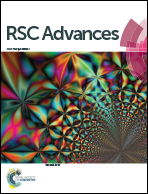Systematic study of the substitution effect on the tetrel bond between 1,4-diazabicyclo[2.2.2]octane and TH3X†
Abstract
A tetrel bond was characterized in the complexes of 1,4-diazabicyclo[2.2.2]octane (DABCO) with TH3X (T = C, Si, Ge; X= –Me, –H, –OH, –NH2, –F, –Cl, –Br, –I, –CN, –NO2). DABCO engages in a weak tetrel bond with CH3X but a stronger one with SiH3X and GeH3X. SiH3X is favorable to bind with DABCO relative to GeH3X, inconsistent with the magnitude of the σ-hole on the tetrel atom. The methyl group in the tetrel donor weakens the tetrel bond but an enhancing effect is found for the other substituents, particularly –NO2. The substitution effect is also related to the nature of the tetrel atom. The halogen substitution from F to I has a weakening effect in the CH3X complex but an enhancing effect in the SiH3X complex and a negligible effect in the GeH3X complex. The above abnormal results found in these complexes can be partly attributed to the charge transfer from the lone pair on the nitrogen atom of DABCO into the anti-bonding orbital σ*(T–X) of TH3X. The stability of both SiH3X and GeH3X complexes is primarily controlled by electrostatic interactions and polarization.
![Graphical abstract: Systematic study of the substitution effect on the tetrel bond between 1,4-diazabicyclo[2.2.2]octane and TH3X](/en/Image/Get?imageInfo.ImageType=GA&imageInfo.ImageIdentifier.ManuscriptID=C9RA03351C&imageInfo.ImageIdentifier.Year=2019)


 Please wait while we load your content...
Please wait while we load your content...